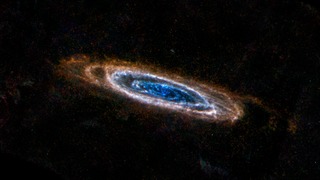Related Research Articles
Infrared astronomy is a sub-discipline of astronomy which specializes in the observation and analysis of astronomical objects using infrared (IR) radiation. The wavelength of infrared light ranges from 0.75 to 300 micrometers, and falls in between visible radiation, which ranges from 380 to 750 nanometers, and submillimeter waves.

Far-infrared astronomy is the branch of astronomy and astrophysics that deals with objects visible in far-infrared radiation.

Andrea Mia Ghez is an American astrophysicist, Nobel laureate, and professor in the Department of Physics and Astronomy and the Lauren B. Leichtman & Arthur E. Levine chair in Astrophysics, at the University of California, Los Angeles. Her research focuses on the center of the Milky Way galaxy.

Submillimetre astronomy or submillimeter astronomy is the branch of observational astronomy that is conducted at submillimetre wavelengths of the electromagnetic spectrum. Astronomers place the submillimetre waveband between the far-infrared and microwave wavebands, typically taken to be between a few hundred micrometres and a millimetre. It is still common in submillimetre astronomy to quote wavelengths in 'microns', the old name for micrometre.

Theta Apodis is a variable star in the southern circumpolar constellation of Apus. It is a variable star with an apparent visual magnitude range of 4.65 to 6.20, which, according to the Bortle Dark-Sky Scale, means it is a faint star but visible to the naked eye from dark suburban skies. The distance to Theta Apodis is approximately 350 light-years, based upon parallax measurements made from the Gaia telescope. It is unusual in that it is a red star with a high proper motion.

AKARI (ASTRO-F) was an infrared astronomy satellite developed by Japan Aerospace Exploration Agency, in cooperation with institutes of Europe and Korea. It was launched on 21 February 2006, at 21:28 UTC by M-V rocket into Earth Sun-synchronous orbit. After its launch it was named AKARI (明かり), which means light in Japanese. Earlier on, the project was known as IRIS.
Amy J. Barger is an American astronomer and Henrietta Leavitt Professor of Astronomy at the University of Wisconsin–Madison. She is considered a pioneer in combining data from multiple telescopes to monitor multiple wavelengths and in discovering distant galaxies and supermassive black holes, which are outside of the visible spectrum. Barger is an active member of the International Astronomical Union.

Alar Toomre is an American astronomer and mathematician. He is a professor of applied mathematics at the Massachusetts Institute of Technology. Toomre's research is focused on the dynamics of galaxies. He is a 1984 MacArthur Fellow.
Michael Sean Brotherton is an American science fiction writer and astronomer. He began writing in 1980.
Lennox Lauchlan Cowie FRS is a British astronomer, and professor at the Institute for Astronomy, University of Hawaiʻi.

J. Davy Kirkpatrick is an American astronomer at the Infrared Processing and Analysis Center at the California Institute of Technology in Pasadena, California. Kirkpatrick's research was named one of the top ten science accomplishments of the first ten years (1992–2002) of the W. M. Keck Observatory and one of the Top 100 Stories of 2011 by Discover Magazine.
Alice Eve Shapley is a professor at the University of California, Los Angeles (UCLA) in the Department of Physics and Astronomy. She was one of the discoverers of the spiral galaxy BX442. Through her time at University of California, Los Angeles (UCLA) she has taught Nature of the Universe, Black Holes and Cosmic Catastrophes, Cosmology: Our Changing Concepts of the Universe, Galaxies, Scientific Writing, AGNs, Galaxies, *and* Writing, and The Formation and Evolution of Galaxies and the IGM. Shapley has committed herself to over a two decades of research and publication in the interest of physics and astronomy.

Vassiliki Kalogera is a Greek astrophysicist. She is a professor at Northwestern University and the director of the Center for Interdisciplinary Exploration and Research in Astrophysics (CIERA). She is a leading member of the LIGO Collaboration that observed gravitational waves in 2015.
Takeshi Oka,, is a Japanese-American spectroscopist and astronomer specializing in the field of galactic astronomy, known as a pioneer of astrochemistry and the co-discoverer of interstellar trihydrogen cation . He is now R.A. Milliken Distinguished Service Emeritus Professor, Departments of Astronomy and Astrophysics, Chemistry; Enrico Fermi Institute; and the College of University of Chicago.
Gillian Susan Wright is a Scottish astronomer who is currently the director of the UK Astronomy Technology Centre in Edinburgh, UK. She has also been involved in the development and construction of the James Webb Space Telescope as the European Principal Investigator for the Mid-Infrared Instrument (MIRI). In 2006 Wright was appointed MBE for services to science.
Stanley Ernest Whitcomb is an American physicist and was the chief scientist at the Laser Interferometer Gravitational-Wave Observatory (LIGO) project when the first direct detection of gravitational waves was made in September 2015.
Reshmi Mukherjee is an Indian-American astrophysicist known for her research on gamma-ray astronomy and blazars, involving work based on the Compton Gamma Ray Observatory, VERITAS, Energetic Gamma Ray Experiment Telescope (EGRET), and Cherenkov Telescope Array collaborations. She is Helen Goodhart Altschul Professor of Physics & Astronomy at Barnard College.
Barbara Jones is an infrared astronomer. She is a professor emerita at the University of California, San Diego.
Gillian Wilson is a British-American astronomer and cosmologist.
Vuk Mandić is a Serbian-American astrophysicist and professor of physics and astronomy at the University of Minnesota. In 2017 he was elected a Fellow of the American Physical Society (APS).
References
- ↑ "APS Fellows 1997". www.aps.org. Retrieved 2019-03-21.